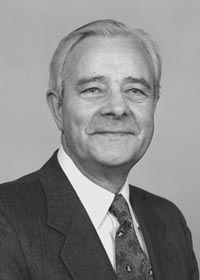In Memoriam: Edward W. "Ted" Webster
1922-2005
by Frank Masse, CHP

The Health Physics Society (HPS) and the community of medical and health physicists lost one of its most distinguished members with the death of Edward W. "Ted" Webster on 17 December 2005, at the age of 83.
Ted was educated in his native England and received his BSc and PhD degrees from the University of London in 1943 and 1946 respectively. He joined the Radiology Department at Massachusetts General Hospital (MGH) in 1950, became a full professor of radiology at the affiliated Harvard Medical School in 1975, and retired from both institutions in 2001 after 51 very active and productive years at the highest professional levels. His long bibliography includes over 100 technical publications in peer-reviewed journals and numerous book chapters and reports. In addition to being a long-term member of HPS, he was a founding member of the American Association of Physicists in Medicine (AAPM), a very active member of the National Council on Radiation Protection and Measurements (NCRP), active in many aspects of the American College of Radiology (ACR), and a member of the BEIR III Committee for the National Academy of Sciences National Research Council, just to mention a few.
Outstanding among the awards and honors bestowed on Ted in his long career was the AAPM Coolidge Award in 1983, the ACR Gold Medal in 1991, and the honor of presenting the 16th Annual Lauriston Taylor Lecture to the 1992 annual meeting of the NCRP. Ted was an honorary member of the NCRP Council at the time of his death.
During his 50 years in the MGH Department of Radiology and on the Harvard Medical School faculty, Ted taught radiological physics to thousands of budding physicians and allied medical personnel, many of whom have risen to prominent positions in the medical community. He constantly strived to improve the quality of radiological imaging, advancing the status and quality control of the radiological facilities at MGH and its affiliated hospitals during a critical 50-year period in the field. Many of his published papers have led to widespread improvement of radiological techniques that have benefited millions of patients.
Many prominent medical physicists benefit from Ted's activities in the development and advancement of the ACR board certification programs, aimed at the improvement and standardization of the professional qualifications of medical physicists in diagnostic and therapeutic radiology.
I was privileged to be in the right place at the right time, spending my career in health and medical physics in Boston beginning in 1952 and crossing paths with Ted many times over the past half century. We joined the HPS in the same year, 1959, as we prepared for President Elda Anderson's 1960 HPS Annual Meeting in Boston, before the New England Chapter was organized. We worked closely together on joint Massachusetts Institute of Technology (MIT)/MGH projects during the 42 years when my MIT career overlapped his MGH years, particularly after the MIT and MGH clinical research units were merged and we were involved in the interacting review committees on both sides of the Charles River. We worked together on many professional society and regulatory committee activities over the years.
In his quiet way, Ted made many notable direct contributions to the benefit and welfare of patients and radiation workers during his career. He was a key participant in a local effort to provide the Boston teaching hospitals with guidance on appropriate radiation exposure limits for volunteer subjects participating in early nuclear medicine research studies in the 1950s, 20 years before the federal government established remarkably similar standards. He devised the method for calculating the effective dose equivalent from the readings from radiation dosimeters worn inside and outside the lead apron in radiology, based on extensive studies of Radiology Department exposure measurements at MGH, the now-standard effective-dose-equivalent calculation used by leading personnel dosimetry services. Ted was a gentle giant in his chosen field and a true gentle man to those who knew him well. His soft-spoken discussions and contributions will be missed.
He is survived by his wife of many years, Dorothea; sons John, Peter, and Edward; daughters Ann Wolfe and Susan MacPhee; and six grandchildren.




